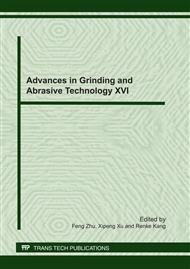p.423
p.429
p.433
p.438
p.443
p.447
p.452
p.457
p.462
Research on Surface Roughness of Nano-Composite Ceramics under Multi-Frequency Ultrasonic Grinding and Dressing
Abstract:
The surface roughness of nano-composite ceramics machined by means of multi-frequency ultrasonic vibration grinding was investigated with the diamond grinding wheel dressed by elliptical vibration. The results indicate that the surface roughness is influenced by ultrasonic vibration frequency, feeding speed, grinding depth. The ultrasonic vibration frequency and the grinding depth are not the higher the better and there are suitable values. The surface roughness gets worse with the increase of feeding speed.
Info:
Periodical:
Pages:
443-446
Citation:
Online since:
July 2011
Authors:
Price:
Сopyright:
© 2011 Trans Tech Publications Ltd. All Rights Reserved
Share:
Citation:


